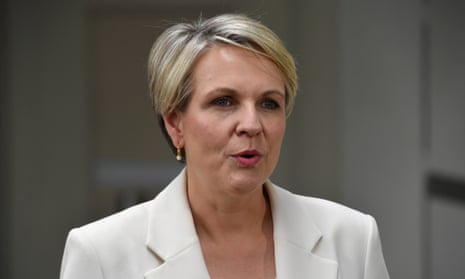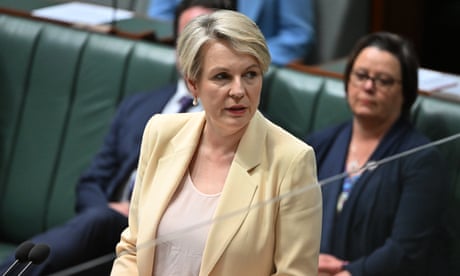To succeed, the EPA will need to be truly independent and be given funding and powers to enforce the law across Australia

Environment minister Tanya Plibersek’s official response to a review of environmental laws has the potential to try to fix most of the problems.
Photograph: Mick Tsikas/AAP
GUDARDIAN AUSTRALIA
Sun 11 Dec 2022
It doesn’t get the attention other issues do, but fixing Australia’s broken environment protection system deserves a place high on a list of the biggest challenges facing the Albanese government.
Last week we got the first substantial look at where the government may be headed. Perhaps not surprisingly, it raised more questions than it answered.
Some of what is proposed – particularly the creation of a federal Environment Protection Agency to decide whether developments can go ahead and uphold a new set of national environmental standards – could revolutionise conservation management across the country. But there are also elements of what the government is proposing that could exacerbate existing problems if not well implemented. Most of the big design decisions are still to come as legislation is drafted in 2023.
A quick reminder of just how bad the problem is: a five-yearly report on the state of the environment found that nature in Australia is in a poor and deteriorating state due to a long list of pressures, including the climate crisis, habitat destruction, the spread of invasive species, pollution and mining. The country is a global leader in extinction, having lost more mammal species than any other continent. Nearly 20 ecosystems are showing signs of collapse or near collapse.
By any measure, the country’s main environment laws, under the Environment Protection and Biodiversity Conservation (EPBC) Act 1999, are failing. The environment minister, Tanya Plibersek, correctly described the report as a “shocking document” and promised that “under Labor the environment is back on the priority list”. She later announced targets including a goal of “zero extinctions” and protecting 30% of Australian land by 2030.

Tanya Plibersek confirms new environmental protection agency to enforce conservation laws
The state of the environment report tells us just how bold the zero extinction target is. Between 2011 and 2021, 377 animal and plant species were newly listed as threatened matters of national environmental significance. Put bluntly, they are on a path towards extinction. Hardly any have conservation plans or the funding needed to arrest their plight. Many more are likely to be added to the list in the years ahead as the catastrophic toll of the black summer bushfires three years ago becomes clearer.
We could spend an age listing the failures of the EPBC Act, but three major problems stand out. Far too much of the environmental damage in Australia isn’t referred for assessment under national law before it happens. To give one galling example: hundreds of thousands of hectares of primary and re-growing native forest are bulldozed every year, but 93% of the area cleared between 2000 and 2017 was not even considered under the national laws because it happened without being referred to the commonwealth government for assessment.
It means no one is responsible for overseeing most of the damage. Instead, we have a mix of mostly inadequate state and territory laws, some industry exemptions, failing environmental offset schemes, little to no data collection and a whole lot of authorities turning a blind eye.
Secondly, with few exceptions (a ban on nuclear power, for example) the environment minister of the day has near total discretion in deciding how to apply the law. Most who have held the position have prioritised doing the minimum necessary to allow developments to go ahead. These developments are nearly always considered in isolation. Their cumulative impact is routinely ignored.
Third, the laws are silent on the climate crisis. A climate trigger, which would allow fossil fuel developments to be blocked or curtailed based on their greenhouse gas emissions, has long been discussed but never introduced.
Plibersek’s announcement last week of the government’s response to a two-year-old review of the EPBC Act by the former competition watchdog, Prof Graeme Samuel, addresses only some of these issues directly.
The creation of a national EPA – a step that goes further than what Samuel recommended – and the introduction of environmental standards against which conservation protection decisions and major development applications must be measured are potentially transformational steps. To succeed, the EPA will need to be truly independent, have conservation as its primary goal, and be given the funding and powers necessary to enforce the law across the country. The standards will need to be specific and detailed enough to work as measurable benchmarks.
Sun 11 Dec 2022
It doesn’t get the attention other issues do, but fixing Australia’s broken environment protection system deserves a place high on a list of the biggest challenges facing the Albanese government.
Last week we got the first substantial look at where the government may be headed. Perhaps not surprisingly, it raised more questions than it answered.
Some of what is proposed – particularly the creation of a federal Environment Protection Agency to decide whether developments can go ahead and uphold a new set of national environmental standards – could revolutionise conservation management across the country. But there are also elements of what the government is proposing that could exacerbate existing problems if not well implemented. Most of the big design decisions are still to come as legislation is drafted in 2023.
A quick reminder of just how bad the problem is: a five-yearly report on the state of the environment found that nature in Australia is in a poor and deteriorating state due to a long list of pressures, including the climate crisis, habitat destruction, the spread of invasive species, pollution and mining. The country is a global leader in extinction, having lost more mammal species than any other continent. Nearly 20 ecosystems are showing signs of collapse or near collapse.
By any measure, the country’s main environment laws, under the Environment Protection and Biodiversity Conservation (EPBC) Act 1999, are failing. The environment minister, Tanya Plibersek, correctly described the report as a “shocking document” and promised that “under Labor the environment is back on the priority list”. She later announced targets including a goal of “zero extinctions” and protecting 30% of Australian land by 2030.

Tanya Plibersek confirms new environmental protection agency to enforce conservation laws
The state of the environment report tells us just how bold the zero extinction target is. Between 2011 and 2021, 377 animal and plant species were newly listed as threatened matters of national environmental significance. Put bluntly, they are on a path towards extinction. Hardly any have conservation plans or the funding needed to arrest their plight. Many more are likely to be added to the list in the years ahead as the catastrophic toll of the black summer bushfires three years ago becomes clearer.
We could spend an age listing the failures of the EPBC Act, but three major problems stand out. Far too much of the environmental damage in Australia isn’t referred for assessment under national law before it happens. To give one galling example: hundreds of thousands of hectares of primary and re-growing native forest are bulldozed every year, but 93% of the area cleared between 2000 and 2017 was not even considered under the national laws because it happened without being referred to the commonwealth government for assessment.
It means no one is responsible for overseeing most of the damage. Instead, we have a mix of mostly inadequate state and territory laws, some industry exemptions, failing environmental offset schemes, little to no data collection and a whole lot of authorities turning a blind eye.
Secondly, with few exceptions (a ban on nuclear power, for example) the environment minister of the day has near total discretion in deciding how to apply the law. Most who have held the position have prioritised doing the minimum necessary to allow developments to go ahead. These developments are nearly always considered in isolation. Their cumulative impact is routinely ignored.
Third, the laws are silent on the climate crisis. A climate trigger, which would allow fossil fuel developments to be blocked or curtailed based on their greenhouse gas emissions, has long been discussed but never introduced.
Plibersek’s announcement last week of the government’s response to a two-year-old review of the EPBC Act by the former competition watchdog, Prof Graeme Samuel, addresses only some of these issues directly.
The creation of a national EPA – a step that goes further than what Samuel recommended – and the introduction of environmental standards against which conservation protection decisions and major development applications must be measured are potentially transformational steps. To succeed, the EPA will need to be truly independent, have conservation as its primary goal, and be given the funding and powers necessary to enforce the law across the country. The standards will need to be specific and detailed enough to work as measurable benchmarks.
No comments:
Post a Comment